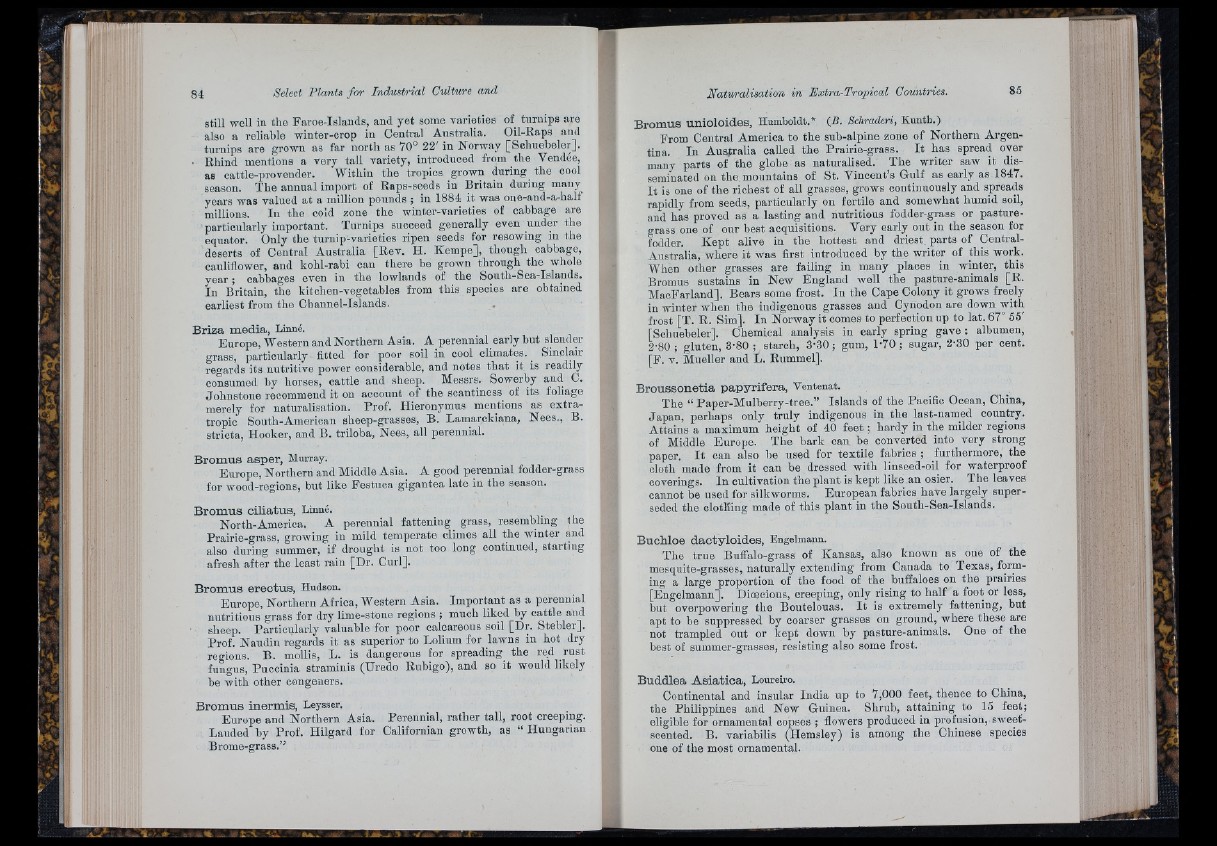
still well in the Faroe-Islands, and yet some varieties of turnips are
also a reliable winter-crop in Central Australia. Oil-Eaps and
turnips are grown as far north as 70° 22' in Norway [Schuebeler].
■ Rhind mentions a very tall variety, introduced from the Vendée,
as cattle-provender. Within the tropics grown during the cool
season. The annual import of Raps-seeds in Britain during many
years was valued a t a million pounds ; in 1884 it was one-and-a-half
millions. In the cold zone the winter-varieties of cabbage are
particularly important. Turnips succeed generally even under the
equator. Only the turnip-varieties ripen seeds for resowing m the
deserts of Central Australia [Rev. H. Kempe], though cabbage,
cauliflower, and kohl-rabi can there be grown through the whole
y e a r; cabbages even in the lowlands of the South-Sea-Islands.
in Britain, the kitchen-vegetahles from this species are obtained
earliest from the Channel-Islands,
B r iz a m e d ia , Linné.
Europe, Western and N orthern Asia. A perennial early but slender
grass, particularly fitted for poor soil in cool climates. ^ Sinclair
regards its nutritive power considerable, and notes th a t it is readily
consumed by horses, cattle and sheep. Messrs. Sowerby and G.
Johnstone recommend it on account of the scantiness of its foliage
merely for naturalisation. Prof. Hieronymus mentions as extra-
tropic South-American sheep-grassas, B. Lamarckiana, Nees., B.
stricta, Hooker, and B. triloba, Nees, all perennial.
B r om u s a s p e r , Murray.
Europe, Northern and Middle A sia. A good perennial fodder-grass
for wood-regions, but like Festuca gigantea late in the season.
B r o m u s c il i a tu s , Linné.
North-America. A perennial fa tten in g _ grass, resembling ihe
Prairie-grass, growing in mild temperate climes all the winter and
also during summer, if drought is not too long continued, starting
afresh after the least rain [Dr. Curl].
B r o m u s e r e o tu s , Hudson.
Europe, Northern Africa, Western Asia. Important as a perennial
nutritious grass for dry lime-stone regions ; much liked by cattle and
sheep. Particularly valuable for poor calcareous soil [Dr. Stebler].
Prof. Naudin regards it as superior to Lolium for lawns in hot dry
regions. B. mollis, L. is dangerous for spreading^ the red rust
fungus, Pucciuia straminis (Uredo Ruhigo), and so it would likely
be with other congeners.
B r o m u s in e rm is , Leysser.
Europe and Northern Asia. Perennial, rather tall, root creeping.
Lauded by Prof. Hilgard for Californian growth, as “ Hungarian
Brome-grass.”
B rom u s u n io lo id e s , Humboldt.* {B. Schraderi, Kunth.)
From Central America to the sub-alpine zone of Northern Argentina.
In Australia called the Prairie-grass. I t has spread oyer
many parts of the globe as naturalised. The writer saw it disseminated
on the mountains of St. Vincent’s Gulf as early as 1847.
I t is one of the richest of all grasses, grows continuously and spreads
rapidly from seeds, particularly on fertile and somewhat humid soil,
and has proved as a lasting and nutritious fodder-grass or pasture-
grass one of our best acquisitions. Very early out in the season for
fodder. Kept alive in the hottest and driest parts of Central-
Anstralia, where it was first introduced by the writer of this work.
When other grasses are failing in many places in winter, this
Bromus sustains in New England well the pasture-animals [R.
MacFarland]. Bears some frost. In the Cape Colony it grows freely
in winter when the indigenous grasses and Cynodon are down with
frost [T. E. Sim]. In Norway it comes to perfection up to lat. 67° 55'
[Solinebeler]. Chemical analysis in early spring gave : albumen,
2-80; gluten, 3 ’80 ; starch, 3 '3 0 ; gum, 1'70 ; sugar, 2‘30 per cent.
[F. V. Mueller and L. Rummel].
B r o u s s o n e t i a p a p y r if e r a , Ventenat.
The “ Paper-Mulberry-tree.” Islands of the Pacific Ocean, China,
Japan, perhaps only truly indigenous in the last-named country.
Attains a maximum height of 40 feet ; hardy in the milder regions
of Middle Europe. The bark can be converted into very strong
paper. I t can also lie used for textile fabrics ; furthermore, the
cloth made from it can be dressed with iinseed-oil for waterproof
coverings. In cultivation the plant is kept like an osier. The leaves
cannot be used for silkworms. European fabrics have largely superseded
the olotliing made of this plant in the South-Sea-Islands.
B u c h lo e d a c ty lo id e s , Engelmann.
The true Buffalo-grass of Kansas, also known as one of the
mesquite-grasses, naturally extending from Canada to Texas, forming
a large proportion of the food of the buffaloes on the prairies
[Engelmann]. Dicecions, creeping, only rising to half a foot or less,
but overpowering the Boutelouas. I t is extremely fattening, but
apt to be suppressed by coarser grasses on ground, where these are
not trampled out or kept down by pasture-animals. One of the
best of summer-grasses, resisting also some frost.
B u d d le a A s ia t ic a , Loureiro.
Continental and insular India up to 7,000 feet, thence to China,
the Philippines and New Guinea. Shrub, attaining to 15 feet;
eligible for ornamental copses ; flowers produced in profusion, sweet-
scented. B. variabilis (Hemsley) is among the Chinese species
one of the most ornamental.